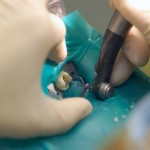
Root canal treatment is conducted routinely adverse effects such as treatment related nerve injuries from mechanical, chemical, or thermal trauma to nerve bundles are uncommon. During obturation of the root canal the filling material should be confined to the root canal space without extending to periapical tissues or other neighboring structures. However, filling material can be accidental extruded into these structures resulting in altered sensation.
The aim of this review was to evaluate the literature regarding the prognosis of altered sensation after extrusion of root canal filling materials and the possible factors influencing it.
Methods
Searches were conducted in the Medline, Scopus, HealthInfonet (http://www.healthinfonet.ecu.edu.au), Closing the Gap Clearinghouse (http://www.aihw.gov.au/closingthegap), and OpenGrey databases for clinical studies that reported on altered sensation after extrusion of root canal filling materials during endodontic treatments.
Two reviewers independently selected studies and abstracted data. With studies being assessed for risk of bias.
Results
- 28 studies (1 case series, 27 case reports) involving a total of 84 patients were included.
- Immediate treatment was performed in 7 (8%) cases, delayed treatment in 27 (32%) cases with 50 (60%) cases having no treatment.
- The average follow-up time was 10 months (range, 0–42 months).
- Of the treated cases,
- 23(68%) cases had surgical care, 8 (24%) non-surgical case and 3 (9%) cases, both surgical and nonsurgical treatments.
- In 18 (53%) cases, a full recovery was reported; in 13 (38%) cases, a partial recovery was reported; and in 3 (9%) cases, no recovery was reported.
- The full recovery rate of the reported non-surgically treated cases was higher than the recovery rate of the reported surgically treated cases (63% and 46%, respectively).
Conclusions
The authors concluded
Current scientific knowledge regarding the prognosis of nerve injuries caused by over extruded endodontic materials relies primarily on case reports and 1 case series that are considered as a low level of evidence. Therefore, the clinical implications of the current analysis of the literature should be adopted cautiously and reassessed in the future as new data accumulate. Based on the currently available literature, it seems that most cases of altered sensation after extrusion of root canal filling materials fully recover or at least partially recover over time. Specific tooth locations, types of extruded materials, the obturation technique, and the timing and type of treatment after the injury may affect the nerve injury prognosis.
Comments
As the authors note this review is limited to a small number of case reports and a single case series, which accounts for 50% of the patients included in this review. The case report or case series is a traditional method of reporting or highlighting rare or uncommon clinical cases or issues. As with many other study designs the more consistently that key items are reported in these studies the easier it is for reviews to combine them to in reviews. It would there be helpful if dental journals and authors were to adopt the CARE checklist in future. The agreement of a common outcome measures (COMET initiative) for reporting would also assist future studies.
Links
Primary paper
Rosen E, Goldberger T, Taschieri S, Del Fabbro M, Corbella S, Tsesis I. The Prognosis of Altered Sensation after Extrusion of Root Canal Filling Materials: A Systematic Review of the Literature. J Endod. 2016 Apr 28. pii: S0099-2399(16)30107-8. doi: 10.1016/j.joen.2016.03.018. [Epub ahead of print] PubMed PMID: 27133502.
Other references

Nerve injuries caused by over-extruded endodontic materials https://t.co/t2V1ac9Fsw
Over-extruded endodontic materials-prognosis of nerve injuries https://t.co/t2V1ac9Fsw
Nerve injuries due to over-extruded endodontic materials https://t.co/t2V1ac9Fsw
Don’t miss – Prognosis of nerve injuries caused by over-extruded endodontic materials https://t.co/t2V1ac9Fsw